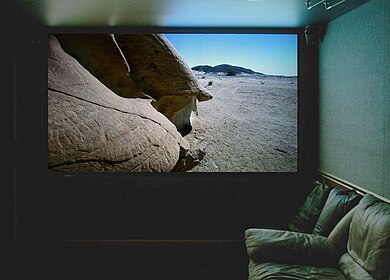High-definition television (HDTV) is a digital television broadcasting system with greater resolution than traditional television systems (NTSC, SECAM, PAL). HDTV is digitally broadcast, because digital television (DTV) requires less bandwidth if sufficient video compression is used. HDTV technology was introduced in the U.S. in the 1990s by the Digital HDTV Grand Alliance, a group of television companies.[1][2]
History of high-definition television
In 1949, France launched 819 lines television, first high definition public television network (778 active lines). This 819 lines network remained operational until 1983.[citation needed]
In 1958, the U.S.S.R created Трансформатор (Transformer), the first high-resolution (definition) television system capable of producing an image composed of 1,125 lines of resolution for the purpose of television conferences among military commands; as it was a military product, it was not commercialised.[3]
In 1969, Nippon Hōsō Kyōkai (NHK) first developed commercial, high-definition television, [4] yet, the system was not commercialized until late in the 1990s.
In 1983, the International Telecommunication Union ITU-R set up a working party (IWP11/6) with the aim of setting a single international HDTV standard. This WP considered many views and through the 1980s served to encourage development in a number of video digital processing areas such as conversion between 30/60 and 25/50 picture rates using motion vectors that lead to other outcomes. While a single standard was never finalized, a common aspect ratio of 16:9 was agreed to at the first meeting at the BBC's R & D establishment at Kingswood Warren. Initially the Japanese 5:3 ratio was considered but a proposal to widen it to 5 1/3:3 = 16:9 was accepted. The ITU-R Recommendation BT.709 includes 16:9, colorimetry and the 1080i (1,080 actively-interlaced lines of resolution) and the 1080p (1,080 progressively-scanned lines). It also included the 1440 x 1152 HDMAC scanning format. 720p formats were strongly resisted by some ITU-R members and were not standardized there. Both 1920 x 1080 and 1280 x 720p (720 progressively-scanned lines), systems for a range of frame and field rates are also defined by several SMPTE standards.
No matter how hard developers tried, and despite the over 20 different standards proposed, high definition television lacked the basics of any successful media application; that is the means of distributing it.
First HDTV commercial experiments as NHK's MUSE required over four times the bandwidth of a standard definition broadcast, and despite the effort made to shrink the required bandwidth in about 2 times of that of the SDTV's, it still was distributable only by satellite.
Recording and reproducing HDTV signal was also a technical challenge in the early years of HDTV.
It was not before the first decade of the new millennium, that storage means of enough capacity and computer processing power for dense compression algorithms made commercial applications of HDTV affordable for consumers and profitable for TV channels or the video rental industry.
Digital HDTV was finally viable due to the evolution of TV broadcasting, where the broadcasting systems all over the world were designed from scratch to use digital means of transmission. Thus, through digital compression equipment, and the evolution of standards such as MPEG 2, H264, a single TV channel could be used either for broadcasting up to 5 TV programs of standard definition, or for broadcasting up to 2 channels of high definition.
High-definition television refers to the image resolution and, loosely, to photo- and videographic media capable of such image resolution, i.e. photographic film and digital video. Current HDTV broadcast standards are in the ATSC and DVB specifications. HDTV is capable of cinema-quality audio, because it uses the Dolby Digital (AC-3) format to support the 5.1 surround sound system.
http://en.wikipedia.org/wiki/High-definition_television

No comments:
Post a Comment